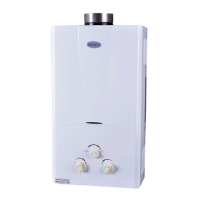1110
This kind of damage will result in water running freely into the space where the
water heater is located, with can cause flooding. If your water heater is installed in a
geographic location that sees very low sustained temperatures, you MUST install a
backflow preventer on your heater's vent pipe. This will ensure that cold air cannot
fall down into the water heater and cause freezing damage. Damage to the unit or
residence caused by freezing is not covered under warranty and responsibility for
this type of damage is disclaimed by Marey Heater Corporation.
- All venting must be done in accordance with local codes and regulations. Local
building codes from city to city and state to state will vary. Some jurisdictions may
allow venting material not allowed by other jurisdictions.
- ALL jurisdictions in North America allow for Z-Vent material to be used for venting
tankless hot water heaters. The condensation of a tankless water heater is slightly
more acidic than that of a standard water heater. Z-Vent is double walled stainless
steel vent pipe made specifically for venting tankless heaters. Z-Vent is intended
for lifetime use and will never corrode or rust.
- Z-Vent material is available at most home improvement stores, and can be found
at many online retailers as well.
- SOME jurisdictions in North America allow for B-Vent to be used. B-Vent is double
walled galvanized vent pipe made for standard water heaters and stove vent pipe.
B-Vent is not lifetime material and will eventually corrode after extended use.
Before deciding what material to use, you MUST check your local building codes to
see what is allowed in your jurisdiction. If you choose to use B-Vent, you MUST
check it at least monthly for corrosion and replace vent pipes immediately if
corrosion is detected.
- Diameter of the vent pipe is 4” for 5L, 4” for 10L, and 5” for 16L units. Use the
coupler provided with your unit for installation on the 5L and 10L units. Vent pipe
attaches directly to the unit in 16L models.
- Through wall installations: Use (2) 45 degree elbows, (1) piece of straight pipe no
longer than 18” in length, one piece of straight pipe no longer than 42” in length, one
wind/rain cap and one condensation drain.
- From the outlet at the top of the water heater, attach the first 45 degree elbow with
a vent pipe coupler to secure it to the unit. Once the elbow is attached, use it as a
guide to cut a hole through the wall at a 45 degree upward angle, at a slightly larger
diameter than the outlet pipe. Install the 18” piece of straight pipe to the 45 degree
elbow and pass it through the hole in the wall. Note: If the overall thickness of your
wall exceeds 18”, the length of the first pipe can be extended up to 24”. If this is the
case, reduce the length of the second pipe to 36”. Total venting distance should not
exceed 60”.
Hot Water Outlet
- The hot water outlet joint is 1/2”NPT pipe thread.
- The hot water outlet should be connected by flexible tubing or rigid PVC of the
type intended for use with hot water.
- The inner diameter of the water outlet pipe (including the valve) shouldn´t
be less than 3/8”. Larger diameter pipe is acceptable as long as the appropriate
adapters are used.
- After connecting, fully open the cold water supply to confirm the flow of water and
to check for leaks. Correct leaks as necessary.
Installing the Gas Supply
The gas inlet joint is 1/2”NPT pipe thread. Very Important: Use Teflon tape for gas
or gas pipe paste between the unit and the gas inlet pipe connector.
-For small bottle Liquid Propane installations: Connect the gas supply to your
propane bottle using a standard rubber Liquid Propane hose and low pressure
regulator. Optimal pressure for your unit is .41-.5 PSI, the same as a typical gas
grill. Pressures set outside this range may result in inconsistent behavior from your
water heater.
- For whole house Liquid Propane or Natural Gas Installations: The unit should be
connected directly to the home gas supply using black iron gas pipe or the braided
metal gas appliance hoses located in the water heater section of your local home
improvement store. WARNING: THIS TYPE OF CONNECTION MUST BE
MADE BY A PROFESSIONAL. Please note that Natural Gas units require .25-.5
PSI for your unit to operate correctly. If you are unsure of your gas pressure,
contact your gas company.
After the gas inlet is connected, open the gas supply valve and check for gas leaks
at all connections by spraying with soapy water and watching for bubbles. Do not
skip this step! Adjust or repair leaks as needed.
- All gas connections must be made in accordance with local building codes and
regulations.
Installing the Exhaust Pipe
WARNING! There is water contained in the coils of your water heater at all times. If
your water heater is exposed to freezing temperatures, the water in the coils could
freeze, causing a break in the heat exchanger of the unit.

